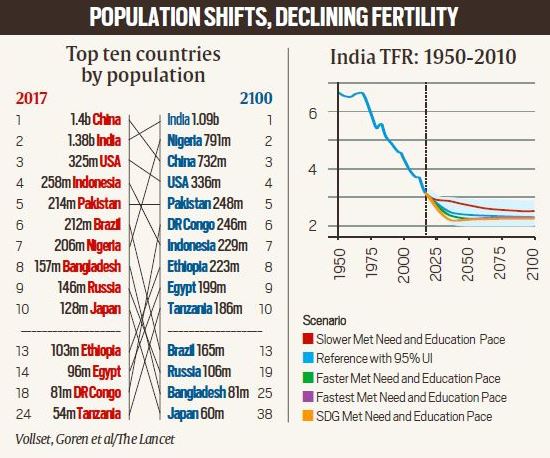Why in news?
Recent Lancet’s report said that, forecasts for China and India peaked before 2050 and both countries thereafter had steep declining trajectories.

World to see the peak
- A new analysis published in The Lancet has projected that the world population will peak much earlier than previously estimated.
- It projects the peak at 9.73 billion in 2064, which is 36 years earlier than the 11 billion peaks projected for 2100 by last year’s UN report World Population Prospects.
- For 2100, the new report projects a decline to 8.79 billion from the 2064 peak.
5 most populated countries
- The five largest countries in 2100 are projected to be India, Nigeria, China, the U.S. and Pakistan.
- However, these forecasts showed different future trajectories between countries.
- Nigeria is forecast to have continued population growth through 2100 and was expected to be the second-most populous country by then.
Predictions on India’s population
- For India, the report projects a peak population of 1.6 billion in 2048, up from 1.38 billion in 2017.
- By 2100, the population is projected to decline by 32% to 1.09 billion.
- However, meeting UN Sustainable Goal Development targets, the peak would be earlier and see a population decline to 929 million.
- Conventional wisdom is that though a decline in population is expected, it is expected to begin only around 2046.
- The fall according to the latest 2019 assessment by the UNDP calculation, is expected to see India’s population settle at a little over 1.4 billion.
Reasons for fall
- The sharper fall is due to the assumption that all women globally will have much higher access to contraception and education.
- This scenario will lead to a sharper reduction in the Total Fertility Rate, a metric that shows on average how many children a woman must have to keep replenishing the population.
- A TFR is lower than 2.1leads to a decline in a country’s population.
Background
The population pyramid (The age-sex pyramid)
The age-sex structure of a population refers to the number of females and males in different age groups. A population pyramid is used to show the age-sex structure of the population. The shape of the population pyramid reflects the characteristics of the population. The left side shows the percentage of males while the right side shows the percentage of women in each age group. The following three diagrams show different types of Population Pyramids.
Expanding Population
The age-sex pyramid in such a case is a triangular shaped pyramid with a wide base and is typical of less developed countries. These have larger populations in lower age groups due to high birth rates.

Constant Population
Here, the age-sex pyramid is bell shaped and tapered towards the top. This shows birth and death rates are almost equal leading to a near constant population.

Declining Population
This pyramid has a narrow base and a tapered top showing low birth and death rates. The population growth in developed countries is usually zero or negative.

Thank you!





